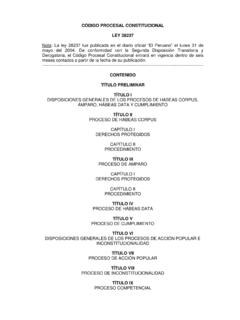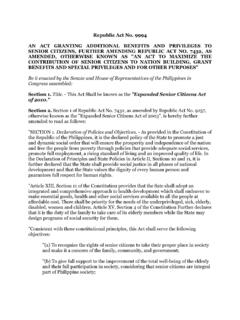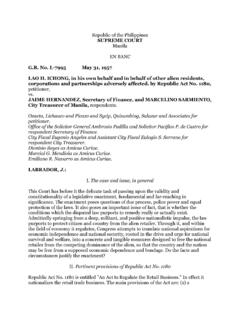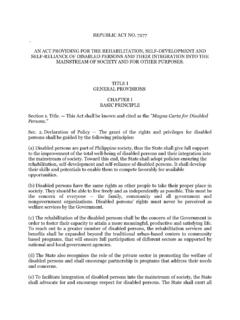Transcription of What Is Gender-Based Violence? - University of Minnesota
1 What Is Gender-Based violence ? Running Time: 3 hours Materials: Flipchart and flipchart stand/chalkboard, markers;. Handout: Declaration on the Elimination of violence Against Women Target Audience: can be used for awareness-raising with various audiences/participants Introduction Facilitator: violence against women is a persistent and universal problem occurring in every culture and social group. Around the world, at least one in every three women has been beaten, coerced into sex, or otherwise abused in her lifetime most often by someone she knows, including a member of her own family, an employer or a co-worker. violence against women has been called the most pervasive yet least recognized human rights abuse in the world.
2 Accordingly, the Second World Conference on Human Rights in Vienna in 1993 and the Fourth World Conference on Women in 1994 gave priority to this issue, which jeopardizes women's lives, bodies, psychological integrity and freedom. violence against women is often known as Gender-Based ' violence because it partly stems from women's subordinate status in society. During this session we will examine the meanings of the concept gender- based' violence , what types of violence are considered Gender-Based ', where Gender-Based violence occurs, who are its main victims and perpetrators. We will also explore Gender-Based violence as a violation of women's human's rights.
3 Learning Objectives: Facilitator: At the end of this session, participants will be able to: - Define Gender-Based violence . - Identify different types and sites of Gender-Based violence , its main victims and perpetrators. - Discuss what Gender-Based violence is and why it is a violation of women's human rights. - Analyze Gender-Based violence from the women's human rights perspective. Activity 1: Gender-Based violence : Definitions 1. Facilitator leads a brainstorming session to create a list of words that describe Gender-Based violence . Facilitator asks each of the participants to share their ideas randomly or in turn. The ideas are not criticized or discussed; participants may build on ideas voiced by others.
4 The questions for brainstorming are: What does the phrase Gender-Based violence ' mean to you? What acts do you qualify as violence '? v Write down each ans wer as they are offered on a flipchart without any comments, notes or questions for 5-7 minutes. After discussing the ideas, post the list on the wall so it is visible throughout the training workshop. 2. Facilitator summarizes the results of the brainstorming and highlights the following concepts: w Gender-Based violence is violence against women based on women's subordinate status in society. It includes any act or threat by men or male dominated institutions that inflict physical, sexual , or psychological harm on a woman or girl because of their gender.
5 In most cultures, traditional beliefs, norms and social institutions legitimize and therefore perpetuate violence against women. w Gender-Based violence includes physical, sexual and psychological violence such as domestic violence ; sexual abuse, including rape and sexual abuse of children by family members; forced pregnancy; sexual slavery; traditional practices harmful to women, such as honor killings, burning or acid throwing, female genital mutilation, dowry-related violence ; violence in armed conflict, such as murder and rape; and emotional abuse, such as coercion and abusive language. Trafficking of women and girls for prostitution, forced marriage, sexual harassment and intimidation at work are additional examples of violence against women.
6 W Gender violence occurs in both the public' and private' spheres. Such violence not only occurs in the family and in the general community, but is sometimes also perpetuated by the state through policies or the actions of agents of the state such as the police, military or immigration authorities. Gender-Based violence happens in all societies, across all social classes, with women particularly at risk from men they know. 3. Facilitator divides participants into pairs and allows them 10-15 minutes to discuss which major types of violence occur in the family, community/society, and the ones perpetrated or condoned by the state. Prepare two flipcharts with major types and sites of Gender-Based violence prior to the exercise.
7 During the discussion, display only the flipchart listing major types of gender violence , leaving the one listing the sites of gender violence covered until the end of the discussion. Types of Gender-Based violence Sites of Gender-Based violence w Overt physical abuse (includes battering, Family sexual assault , at home or in the workplace) w is one of the primary sites of gender violence . w prepares its members for social life, forms gender stereotypes and perceptions w Psychological abuse (includes deprivation of of division of labor between the sexes. liberty, forced marriage, sexual harassment, w is the arena where physical abuses (spousal battering, sexual assault , sexual at home or in the workplace) abuse) and/or psychological abuses occur.
8 ( domestic violence can also take w Deprivation of resources needed for physical such forms as confinement, forced marriage of woman arranged by her family and psychological well-being (including health without her consent, threats, insults and neglect; overt control of a woman's care, nutrition, education, means of livelihood) sexuality through either forced pregnancy or forced abortion.). w because violence within the family and household takes place in the home, it is w Treatment of women as commodities often seen as a private' issue and information about it is lacking. (includes trafficking in women and girls for sexual exploitation) Community/Society w as a group sharing common social, cultural, religious or ethnic belonging, it perpetuates existing family structure and power inequalities in family and society.
9 W justifies the behavior of male abusers aimed at establishing control over women in the family, and supports harmful traditional practices such as battering and corporal punishment w workplace can also be a site of violence . Either in governmental service or in a business company, women are vulnerable to sexual aggression (harassment, intimidation) and commercialized violence (trafficking for sexual exploitation). State w legitimizes power inequalities in family and society and perpetuates gender- based violence through enactment of discriminatory laws and polities or through the discriminatory application of the law. w is responsible for tolerance of gender violence on an unofficial level ( in the family and in the community).
10 W To the extent that it is the State's recognized role to sanction certain norms that protect individual life and dignity and maintain collective peace, it is the State's obligation to develop and implement measures that redress gender violence . Source: Prevention of domestic violence and Trafficking in Human Beings, Training Manual, Winrock International, Kyiv, Ukraine, 2001, available at 4. Facilitator reconvenes the entire group and asks participants to present the results of their discussion. Facilitator then summarizes the results, reading the information on the sites of gender violence from the flipchart. Facilitator goes on to highlight the following ideas: w The primary inequality that gives rise to Gender-Based violence is the power inequality between women and men.
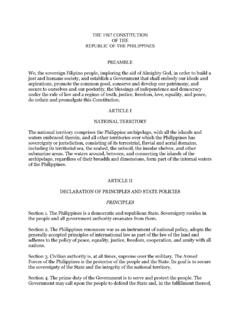
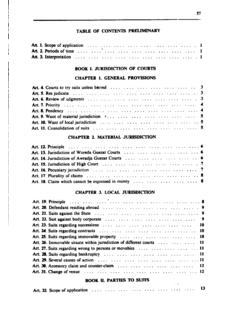

![Cap. 23] CHILDREN AND YOUNG PERSONS](/cache/preview/a/e/5/4/4/e/e/6/thumb-ae544ee647db019dff09ed2c401367af.jpg)

